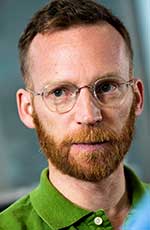Alberta’s oil and gas fields could be in store for another natural resource boom thanks to a University of Alberta-based lithium extraction technology with the ability to unlock the increasingly valuable metal.
Faculty of Science geochemist Dan Alessi, professor in the Department of Earth and Atmospheric Sciences, and former post-doctoral fellow Salman Safari have spun off their technology to extract lithium from oilfield brines in Alberta into a startup called Recion Technologies.
Alessi, who holds the Encana Endowed Chair in Water Resources, explained the world’s demand for lithium is growing every day and is especially driven by increased lithium use in electronic battery technologies found in computers, cellphones and electric cars.
And while demand grows, the traditional sources of lithium – found in hard rock mines around the world or brine pools known as salars, found primarily in South America – are intensely environmentally intrusive.
“We’re trying to fill that supply gap that’s on the horizon – coming in the next decade – with alternative sources of lithium,” said Alessi.
It happens that most oil and gas wells in Alberta produce very saline waters, often five to 10 times saltier than the ocean, deep in the lithosphere. That brine, noted Alessi, is also home to a “dusting” of lithium with concentrations often between 50 and 150 parts per million.
“On face, it’s not a great source of lithium,” said Alessi.
“But Alberta already has the oil and gas infrastructure, which would otherwise cost millions to install.”
He added that the water that comes up with the oil and gas would normally be a waste material.
“We take the water, recover the lithium and return the water for disposal, and there is a very substantial side stream of lithium revenue that could be generated.”
Alessi likens the search for such small quantities of lithium in a sea of brine to looking for a needle in a haystack. For that, he and Safari have developed a highly selective process that separates out the lithium.
Over the past four years, Alessi and Safari have developed similar technologies for two of the biggest startups in Western Canada, before crafting their own unique technology.
“We were approached by another company to work with them and to do research for them,” said Safari, president and CTO of Recion Technologies. “At that point, Dan and I looked at each other and thought maybe we should start a company. It made more sense to have a company spun out from the university.”
Alessi added that the big barrier, right now, is making sure the technology can be scaled up while remaining economical.
“This is very exciting for Alberta because this is a potential domestic source of lithium that is sustainable,” he said. “The other sources – the open-pit mines and salars – are quite inefficient, and they’re environmentally intrusive.”
He added the environmental impact of manufacturing a cellphone, including lithium, is astounding. The lithium batteries that power electric cars have about 10 kg of lithium. “That’s an awful lot of lithium and other elements to be getting from questionable sources.”
Among the obstacles for Alessi and Safari to overcome is creating a technology that holds up to use in the field while processing at least a swimming pool’s worth of brine daily.
“The great thing about our technology is it’s modular,” said Alessi. “It allows us to go to a site where we’re processing 10 cubic metres of brine a day as a demonstration and move quickly to 1,000 or more.”
Alessi’s work received a boost from the U of A’s Future Energy Systems starting earlier this year, and Recion was recently awarded another grant from Alberta Innovates.
“Right now, we’re looking for an industry partner, such as an oil and gas company here in Alberta, because they have access to the brines we need,” said Alessi.
And while Alessi and Safari have the science down pat, they were leery about the business side of the equation. To help, they applied and were accepted into imYEG, the university’s business accelerator partnership with Brass Dome Ventures.
Alessi said the time spent working with a small group of imYEG founders – entrepreneur volunteers who have had success running businesses – to learn how best to grow his idea has been invaluable.
“There are a few people who have been amazing in helping us to identify opportunities to find a partner or to price out a prototype,” he said. “But there’s also a lot of experience on the soft side of business. For example, what’s the appropriate level of selling yourself? In academia, we have a very conservative approach to putting forward ideas that does not necessarily work in business.”
“All of that is coming together to allow us to be mature in our conversations with potential partners.”
| By Michael Brown
This article was submitted by the University of Alberta’s Folio online magazine. The University of Alberta is a Troy Media Editorial Content Provider Partner.
© Troy Media
Troy Media is an editorial content provider to media outlets and its own hosted community news outlets across Canada.



